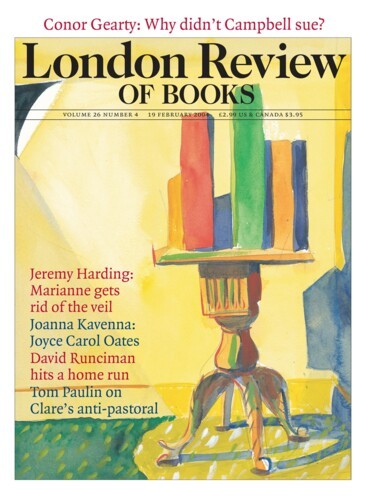Fifteen months ago in these pages I reviewed a book by Khidhir Hamza, who called himself ‘Saddam’s bombmaker’. At the same time I assessed the now notorious government dossier of September 2002 on Iraq’s weapons of mass destruction, together with the more restrained document published by the International Institute of Strategic Studies. I said that Hamza’s evidence, which he had submitted to the US Senate, was carefully tailored nonsense: Iraq did not possess ‘ten tons of uranium and one ton of slightly enriched uranium . . . enough for three nuclear weapons’, as he testified, but five hundred tons of uranium – enough for 140 nuclear weapons. All five hundred tons were harmless, however: it would have needed to be enriched from around 1 per cent to at least 90 per cent uranium-235, before it could be used for weapons. Hamza told the Times that ‘the number of pirated centrifuges’ – to enrich the uranium – ‘that Baghdad has been able to produce, and the rapidity with which the reprocessing programme is being undertaken’, were the reasons for urgent action by the UK and US. But the pirated centrifuges were a figment of Hamza’s imagination: there were no centrifuges in place enriching uranium, and there was no centrifuge assembly plant. The September dossier alleged that Iraq had imported aluminium tubes for centrifuge production, but these were revealed by the International Atomic Energy Agency inspectors to be rocket parts. Not only that: experts in the US and UK intelligence services knew that Iraq was manufacturing copies of the Italian Medusa 81 rocket and that the dimensions of the aluminium tubes matched the specifications of the rocket to a fraction of a millimetre.
The IAEA also showed that the story of Iraq’s attempt to import uranium from Niger was based on forged documents: it was almost certainly an intelligence sting, as I had suggested. We now know, too, that Colin Powell’s televised statement to the UN Security Council concerning Iraq’s mobile biological weapons laboratories was immediately criticised by David Kelly, who recognised them as trucks bought from Marconi for filling balloons with hydrogen. David Kelly and Brian Jones were not the only ones to have doubts about the dossier: similar doubts were expressed by nuclear experts. We shall see what the Butler committee finds.
Where were the bogus stories about Iraq’s supposed nuclear programme coming from? In the case of the Niger connection, the documents could have been forged by an Iraqi exile group, but the available evidence points to MI6 as the sponsor of the forgery. When President Bush cited the supposed uranium deal with Niger in his 2003 State of the Union speech, he named Britain as the source of the information. Seymour Hersh, in a New Yorker article last March, quoted a former American intelligence officer as saying that ‘at least one member of the UN inspection team who supported the American and British position arranged for dozens of unverified and unverifiable intelligence reports and tips-data known as inactionable intelligence to be funnelled to MI6 operatives and quietly passed along to newspapers in London and elsewhere.’
The BBC reported in November that the former UN weapons inspector Scott Ritter, who was one of the few to say before the war that Iraq possessed no weapons of mass destruction, had urged MPs to hold a fresh inquiry into the use of intelligence before the war even started. He said that British intelligence had run a campaign to exaggerate Iraq’s holdings of WMDs. Ritter revealed that he was part of Operation Mass Appeal between the summer of 1997 and August 1998, when he resigned from the UN, and that this was an MI6 operation designed to ‘shake up public opinion’ by passing dubious intelligence on Iraq to the media. Stanley Hoffman, the veteran Harvard professor of European studies, wrote recently that Blair, ‘in his determination to give wholehearted support to the United States over Iraq’, helped the Bush team’s campaign against Saddam Hussein ‘by supplying sometimes dubious "data” provided by [the] British security services’. In the light of the evidence presented to the Hutton Inquiry, it is entirely believable that MI6 helped 10 Downing Street to persuade the British public that there was a case for war, just as the Office of Special Plans in the Pentagon was doing in the United States. After all, John Scarlett, the present chairman of the Joint Intelligence Committee, was a mate of Alastair Campbell’s. Lord Hutton may not have found this significant, but I do.
MI6 has long experience in the dissemination of forged documents to make a political case. In 1924, two MI6 officers leaked a forged letter, purportedly from Zinoviev, the president of the Comintern, to the central committee of the Communist Party of Great Britain calling for class war. Its publication in the Daily Mail brought down the then Labour government.
Send Letters To:
The Editor
London Review of Books,
28 Little Russell Street
London, WC1A 2HN
letters@lrb.co.uk
Please include name, address, and a telephone number.

